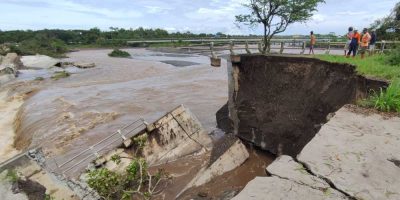As the temperature dipped in the Northern Hemisphere over December 2024, a delayed La Nina weather event finally arrived in the tropical Pacific Ocean, say meteorologists.
Marked by colder surface water in the eastern Pacific — in contrast to El Nino events that bring hotter waters — La Nina could potentially usher cooler weather and more intense storms and rainfall to many parts of the world.
But while it has edged out one of the big contributors to the record-breaking global temperatures over the past year, El Nino, the La Nina weather phase has been relatively weak, according to the National Oceanic and Atmospheric Administration (NOAA) in the US.
As is typical of La Nina, the Pacific trade winds that blow east-west — and which weaken during El Nino — have become stronger again, bringing more clouds and rain to Indonesia.
But the relatively weak and delayed La Nina shift means the weather event will likely be shorter. NOAA’s climate prediction center says there is a 59% chance La Nina will persist through February to April, followed by a 60% chance of neutral conditions from March to May 2025.
If La Nina lasted until summer in the northern hemisphere, experts say it could increase the chances of more damaging and intense hurricanes in the Atlantic Ocean, for example.
The La Nina and El Nino weather phases are part of the so-called El Nino-Southern Oscillation (ENSO), a climate pattern triggered in the Pacific Ocean that involves changes in wind and ocean temperatures which can influence extreme weather across the globe.
El Nino — “the little boy” in Spanish — was linked to record global temperatures in 2023 that amounted to the hottest year on record. Along with climate change, El Nino contributed to extreme heat waves and drought across Southeast Asia and parts of Africa.
How do El Nino and La Nina come about?
Its “little girl” sister, La Nina, creates weather patterns that, although variable, tend to be cooler and wetter, and can lead to intense storms and hurricanes.
The effects of both El Nino and La Nina can vary considerably, and don’t affect every region of the world. They can also be influenced by other climate events. Both weather patterns can have a huge impact on global agriculture and the well-being of billions of people around the world, already under strain due to the effects of climate change.
How El Nino causes weather extremes
El Nino commonly occurs every two to seven years when regular trade winds moving east-west across the Pacific Ocean weaken and sometimes even reverse.
These winds usually blow across the equator and take warm water from South America toward Southeast Asia and Australia.
But, when the winds start to calm, the warmer water remains in South America and fails to travel west. As the warmth suppresses the usual upswell of cold water in the eastern Pacific, extra heat in the atmosphere typically supercharges regional rainfall and causes flooding in places like northern South America.
Meanwhile, the absence of warm water in the western Pacific can result in drought and extreme temperatures.
El Nino’s disruption of ocean heat can alter the path of jet streams — strong winds far above the ground — that travel the planet, guiding rains. This causes broad climate disruption, including the stalling of the monsoon season in Indonesia and India, but also the reduction of hurricane activity in the Atlantic.
Though researchers have found that the direct impact of El Nino on rainfall in eastern Africa is relatively modest, they say it can kick-start a positive Indian Ocean Dipole, another climate pattern that can bring extreme flooding to the region.
La Nina fuels storms and hurricanes
La Nina, another key phase in the ENSO, has the opposite impact from El Nino as predominant east-west winds become stronger than usual. Typically, La Nina events tend to occur every three to five years.
An increase of warmer water in the west can bring increased rainfall to Australia and Southeast Asia.
La Nina phases can spark drought and wildfires in eastern Pacific regions, from the southwestern United States and Mexico through to South America. However, regional variability means that northeast US states and Canada tend to be wetter and colder during La Nina winters.
La Nina also typically enhances hurricane activity in the Atlantic Basin, a phenomenon that is being exacerbated by record warm ocean surface temperatures in the Atlantic.
Zimbabwe declares drought-induced state of disaster
Impacts hard to predict
Though La Nina and El Nino are natural patterns, their relative impacts can vary depending on their timing, duration and complex climate influences that include human-induced global heating. There is some evidence that climate change has these patterns more frequent and intense.
Scientists have said El Nino and La Nina cycles are likely to hit harder as the planet heats up. Hotter air holds more water and causes more extreme rainfall.
Researchers add that achieving net-zero greenhouse gas emissions through the phasing out of fossil fuels has the potential to limit both global heating and ENSO impacts.
Martin Kuebler also contributed to this report.
Edited by: Tamsin Walker, Jennifer Collins
This article was last updated on January 29, 2025 to include information about the latest La Nina weather event.












